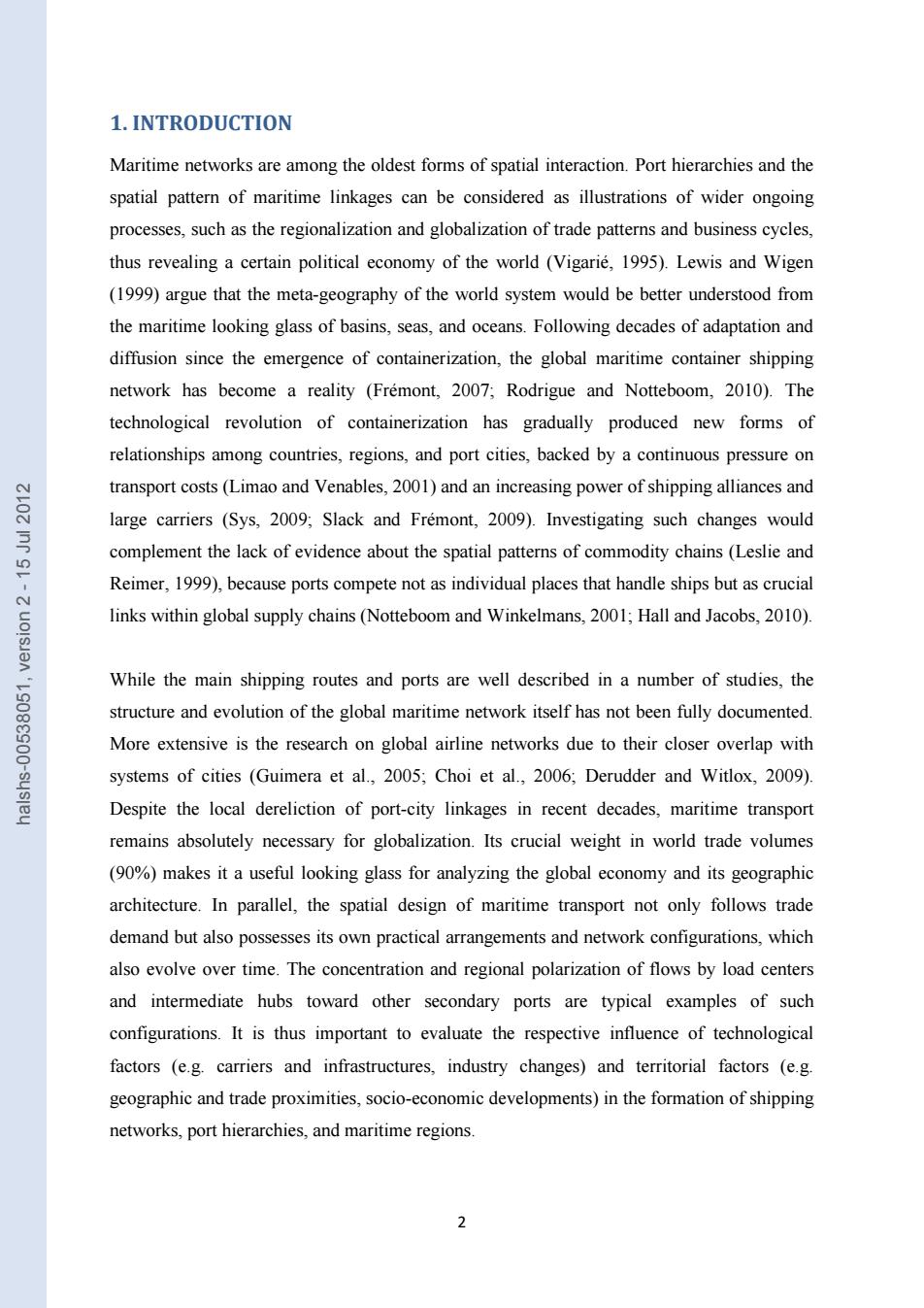正在加载图片...

1.INTRODUCTION Maritime networks are among the oldest forms of spatial interaction.Port hierarchies and the spatial pattern of maritime linkages can be considered as illustrations of wider ongoing processes,such as the regionalization and globalization of trade patterns and business cycles, thus revealing a certain political economy of the world (Vigarie,1995).Lewis and Wigen (1999)argue that the meta-geography of the world system would be better understood from the maritime looking glass of basins,seas,and oceans.Following decades of adaptation and diffusion since the emergence of containerization,the global maritime container shipping network has become a reality (Fremont,2007;Rodrigue and Notteboom,2010).The technological revolution of containerization has gradually produced new forms of relationships among countries,regions,and port cities,backed by a continuous pressure on transport costs(Limao and Venables,2001)and an increasing power of shipping alliances and 点 large carriers (Sys,2009;Slack and Fremont,2009).Investigating such changes would 三 complement the lack of evidence about the spatial patterns of commodity chains(Leslie and Reimer,1999),because ports compete not as individual places that handle ships but as crucial N links within global supply chains(Notteboom and Winkelmans,2001;Hall and Jacobs,2010). 西 While the main shipping routes and ports are well described in a number of studies,the structure and evolution of the global maritime network itself has not been fully documented. More extensive is the research on global airline networks due to their closer overlap with -sus] systems of cities (Guimera et al.,2005;Choi et al.,2006;Derudder and Witlox,2009). 巴 Despite the local dereliction of port-city linkages in recent decades,maritime transport remains absolutely necessary for globalization.Its crucial weight in world trade volumes (90%)makes it a useful looking glass for analyzing the global economy and its geographic architecture.In parallel,the spatial design of maritime transport not only follows trade demand but also possesses its own practical arrangements and network configurations,which also evolve over time.The concentration and regional polarization of flows by load centers and intermediate hubs toward other secondary ports are typical examples of such configurations.It is thus important to evaluate the respective influence of technological factors (e.g.carriers and infrastructures,industry changes)and territorial factors (e.g. geographic and trade proximities,socio-economic developments)in the formation of shipping networks,port hierarchies,and maritime regions. 22 1. INTRODUCTION Maritime networks are among the oldest forms of spatial interaction. Port hierarchies and the spatial pattern of maritime linkages can be considered as illustrations of wider ongoing processes, such as the regionalization and globalization of trade patterns and business cycles, thus revealing a certain political economy of the world (Vigarié, 1995). Lewis and Wigen (1999) argue that the meta-geography of the world system would be better understood from the maritime looking glass of basins, seas, and oceans. Following decades of adaptation and diffusion since the emergence of containerization, the global maritime container shipping network has become a reality (Frémont, 2007; Rodrigue and Notteboom, 2010). The technological revolution of containerization has gradually produced new forms of relationships among countries, regions, and port cities, backed by a continuous pressure on transport costs (Limao and Venables, 2001) and an increasing power of shipping alliances and large carriers (Sys, 2009; Slack and Frémont, 2009). Investigating such changes would complement the lack of evidence about the spatial patterns of commodity chains (Leslie and Reimer, 1999), because ports compete not as individual places that handle ships but as crucial links within global supply chains (Notteboom and Winkelmans, 2001; Hall and Jacobs, 2010). While the main shipping routes and ports are well described in a number of studies, the structure and evolution of the global maritime network itself has not been fully documented. More extensive is the research on global airline networks due to their closer overlap with systems of cities (Guimera et al., 2005; Choi et al., 2006; Derudder and Witlox, 2009). Despite the local dereliction of port-city linkages in recent decades, maritime transport remains absolutely necessary for globalization. Its crucial weight in world trade volumes (90%) makes it a useful looking glass for analyzing the global economy and its geographic architecture. In parallel, the spatial design of maritime transport not only follows trade demand but also possesses its own practical arrangements and network configurations, which also evolve over time. The concentration and regional polarization of flows by load centers and intermediate hubs toward other secondary ports are typical examples of such configurations. It is thus important to evaluate the respective influence of technological factors (e.g. carriers and infrastructures, industry changes) and territorial factors (e.g. geographic and trade proximities, socio-economic developments) in the formation of shipping networks, port hierarchies, and maritime regions. halshs-00538051, version 2 - 15 Jul 2012